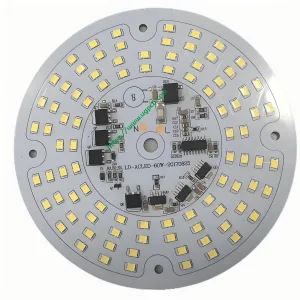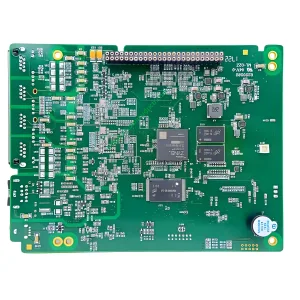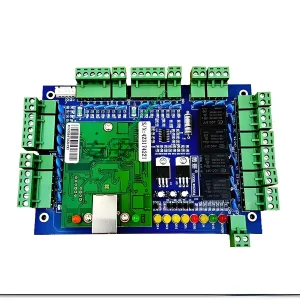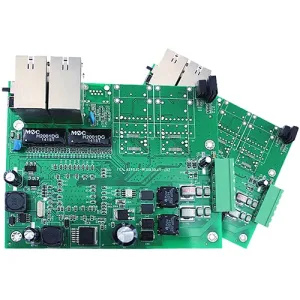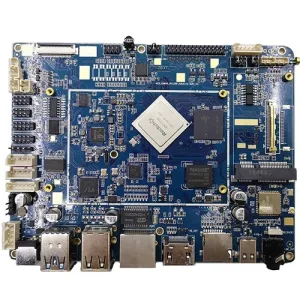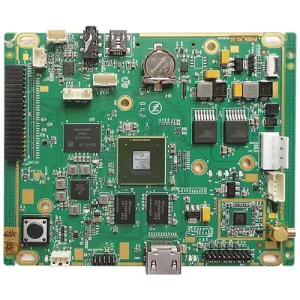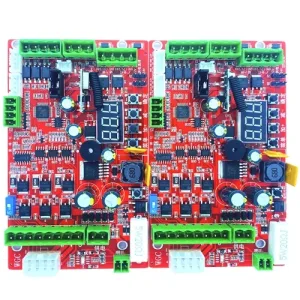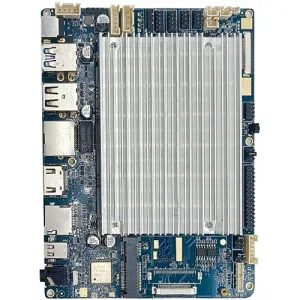Industrial automation refers to the general term for measurement and manipulation of information processing and process control without the direct intervention of human operators in machinery or production processes, based on predetermined goals. Automation technology involves exploring and researching methods and techniques to achieve process automation. It is a comprehensive technology that encompasses mechanical engineering, microelectronics, computer science, machine vision, and other technological fields. The Industrial Revolution was the catalyst for automation technology, which emerged and flourished due to the demands of the industrial era. In turn, automation technology has also propelled industrial progress. Oggi, automation technology is widely applied in fields such as mechanical manufacturing, electricity, construction, transportation, and information technology, becoming a primary means to enhance labor productivity.
Industrial automation is one of the key prerequisites for Germany’s initiation of Industry 4.0, mainly reflected in the fields of mechanical and electrical engineering. IL “embedded systems” currently widely used in German and international manufacturing industries involve embedding mechanical or electrical components into controlled devices. These are specialized computer systems designed for specific applications. Data shows that this “embedded system” generates annual market benefits of up to 20 billion euros, with the figure expected to rise to 40 billion euros by 2020.
Industrial automation technology utilizes control theory, instrumentation, computer, and other information technologies to achieve detection, control, optimization, scheduling, management, and decision-making in industrial production processes, aiming to increase production, improve quality, and reduce consumption while ensuring safety. It is a comprehensive high-tech that includes software, hardware, and systems. As one of the most important technologies in the modern manufacturing field in the 20th century, industrial automation technology primarily addresses issues of efficiency and consistency in production. Whether it is for high-speed mass production enterprises or those pursuing flexibility and customization, the application of automation technology is indispensable. While automation systems do not directly create benefits, they significantly improve enterprise production processes:
- Enhancing production process safety;
- Increasing production efficiency;
- Improving product quality;
- Reducing raw material and energy consumption during production.
According to authoritative international consulting agencies, the investment-to-output ratio for enterprises that implement automation systems is about 1:4 A 1:6. Particularly in capital-intensive enterprises, automation systems account for less than 10% of total equipment investment but play a significant role in generating substantial returns. Traditional industrial automation systems, i.e., mechatronic systems, mainly control equipment and production processes comprising mechanical bodies, power parts, test sensing parts, actuators, drivers, and other hardware components, along with control and signal processing units, and interfaces. Guided by purposeful information flows in software programs and electronic circuit logic, these elements coordinate and integrate organically, forming orderly and regular movements of matter and energy, thereby creating industrial automation systems or products.
In the field of industrial automation, traditional control systems have evolved from base pneumatic instrument control systems, electrical unit combination analog instrument control systems, centralized digital control systems, to distributed control systems (DCS).
With the development of control technology, computer, communications, and networking, information exchange and communication are rapidly covering all levels from factory floor equipment to control management. Industrial PC systems refer to automated technical tools for measuring and controlling industrial production processes (including automatic measuring instruments and control devices) and their electromechanical and process equipment. Oggi, the simplest understanding of automation has also shifted to using generalized machines (including computers) to partially replace, fully replace, or surpass human physical labor.
Development History
First Phase
1940S – early 1960s
Driven by market competition, resource utilization, reduction of labor intensity, improvement of product quality, and meeting the needs of mass production. The main characteristic of this phase was the stage of single-machine automation. Typical achievements and products include CNC machine tools equipped with hardware CNC systems.
Second Phase
Mid-1960s – early 1970s
Driven by intensified market competition requiring quick product updates, high product quality, suitability for medium and large batch production, and reduced labor intensity. This phase was marked by automation production lines. On the basis of single-machine automation, various combined machine tools and production lines emerged, along with software CNC systems applied to machine tools, and the practical application of CAD, CAM software in project design and manufacturing. Hardware processing equipment at this stage suited medium and large batch production. Typical achievements and products include drilling, boring, milling, and other machining automation production lines.
Third Phase
Mid-1970s – present
Market environment changes have made the common problems of multi-variety, small and medium batch production increasingly severe, demanding automation technology to develop in breadth and depth, integrating related technologies to achieve optimal overall performance. Since the early 1970s when American scholars first proposed the concept of CIM, significant changes have occurred in the automation field. The main characteristic is that CIM as a concept and method has gradually been accepted; corresponding technologies integrate dispersed, independent unit automation technologies into an optimized whole. The so-called concept is the strategic thought for enterprises to analyze and overcome existing “bottlenecks” to continuously improve strength and competitiveness; while the corresponding technologies for integration generally include data collection, distribuzione, sharing; network and communication; plant-level equipment controllers; computer hardware and software specifications, standard, ecc. Concurrently, concurrent engineering as a business philosophy and work model has been applied and active in the field of automation technology since the late 1980s, further promoting the integration of unit automation technologies. Typical achievements and products include CIMS factories, flexible manufacturing systems (FMS).
Equipment Technology and Production Management Control
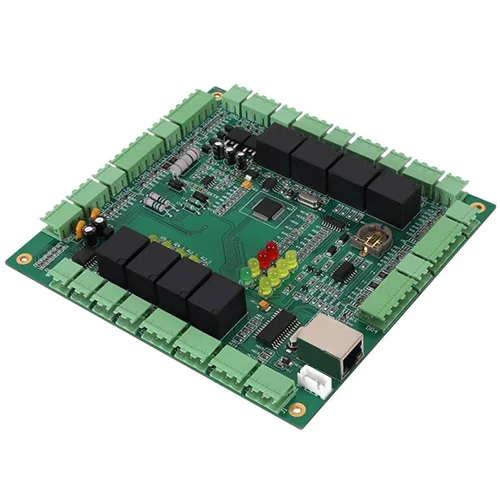
With the development of the national economy and the improvement of people’s living standards, the demand for electrical energy has increased, leading to a corresponding increase in power generation equipment. The structure and operation mode of the power grid have become more complex, with higher demands on the quality of electric power. To ensure user electricity usage, it is necessary to manage and control the power grid.
The tasks of power system operation management and dispatching are complex but can be summarized as follows:
- Maintaining the normal operation of the power system as much as possible. Safety is paramount in power systems. Once an accident occurs, its consequences are unpredictable. Perciò, maintaining the normal operation of the power system is of utmost importance;
- Providing users with high-quality electric power. The three parameters reflecting power quality are voltage, frequency, and waveform. These parameters must be within specified ranges to ensure power quality. Voltage stabilization hinges on adjusting the balance of reactive power in the system, frequency changes reflect the balance of active power throughout the system, and waveform is determined by generators;
- Ensuring economic operation of the power system to minimize generation costs.
The power system is a wide-area distributed system with a large amount of equipment and many information parameters. Power plants send electricity to users through multiple transformer voltage changes before transmission. Voltages are provided to users through transmission lines, varying from low to high and then from high to low for convenient energy transfer. Voltage transformation forms different voltage levels, creating substations of varying voltage levels and transmission lines between them, thus forming a complex power network topology. Power grid dispatching manages and controls according to this topology.
Generalmente, grids set up dispatch centers based on voltage levels, with higher voltage levels corresponding to higher-level dispatch centers. The entire system forms a tiered network diagram. Hierarchical dispatching simplifies the topology of making information transmission more reasonable, thus greatly saving communication equipment and improving system operation stability. According to China’s national conditions, power system dispatching is divided into national dispatch centers, regional network bureau level dispatch control centers, provincial dispatch control centers, district dispatch control centers, and county dispatch centers. Each level directly manages and dispatches the next lower level.
Power Grid Dispatching
Power grid dispatching automation is a general term. Due to different tasks at each level of dispatch center, scales of automation systems vary, but regardless of the level of there is a basic function: monitoring control and data collection, commonly referred to as SCADA system functions.
SCADA mainly includes the following functions:
Data acquisition; Information display; Monitoring and control; Alarm handling; Data storage and reporting; Event sequence recording; Data calculation; RTU processing capabilities; Event review function.
Automatic Generation Control (AGC): The main requirement of the AGC system is to ensure that the power output of generators is not directly controlled by the power plant, but rather globally optimized by the plant’s superior dispatch center based on principles.
Economic Dispatch Control (EDC): The purpose of EDC is to control the distribution of power output among each generator in the power system to minimize the operating costs of the grid. EDC is typically incorporated into AGC.
Security Analysis (SA): The SA function is a proactive feature equipped in grid dispatching. It analyzes the current state of the power grid through computations, predicts potential failures, takes preemptive measures to prevent accidents. If the grid dispatch automation system includes SCADA+AGC/EDC+SA, it is referred to as an Energy Management System (EMS). With advancements in digital transmission and fiber optic communication technologies, grid dispatch automation has also entered the network era. Attualmente, most computer configurations in grid dispatch adopt distributed computing systems. With the development of China’s national economy, China has entered an era of large power grids, large units, and ultra-high voltage transmission. It is fully believed that with the development of new automated power grid systems in China, the level of grid dispatch automation will further improve and reach advanced international levels.
Flexible manufacturing
Introduzione
Flexible manufacturing technology (FMT) encompasses various techniques for programmatically flexible manufacturing of diverse shapes of workpieces. FMT is a technologically intensive group of technologies. All technologies that emphasize flexibility and are suitable for multi-variety, small and medium batch production (including single products) fall under flexible manufacturing technology.
Flexibility can be manifested in two aspects. The first aspect is the system’s ability to adapt to changes in the external environment, which can be measured by the degree to which the system meets the requirements of new products; the second aspect is the system’s ability to adapt to internal changes, such as using it when there are disturbances (per esempio., machine failures). In the absence of disturbances, the ratio of productivity to expected productivity can serve as a measure of flexibility. “Flessibilità” is relative to “rigidity.” Traditional “rigid” automated production lines mainly achieve mass production of single varieties, with the advantage of very high productivity. Due to fixed equipment, the utilization rate of equipment is also very high, making the cost of each product low. Tuttavia, the price is quite expensive, capable of processing only one or a few similar parts. To obtain other types of products, significant structural adjustments must be made and elements within the system reconfigured, often at a cost and investment comparable to building a new production line. Rigid mass production automation lines are only suitable for a few varieties of products and face challenges in adapting to small and medium batch, multi-variety production. As society progresses and living standards improve, markets demand more distinctive products that cater to individualized customer needs in style and functionality. Fierce market competition forces traditional batch production methods to change, requiring improvements to traditional component manufacturing processes. Traditional manufacturing systems cannot meet the market demand for multi-variety, small-variety products, making system flexibility increasingly important for system survival. As the era of mass production gradually gives way to production that adapts to dynamic market changes, a manufacturing automation system’s viability and competitiveness largely depend on its ability to produce different varieties of products at lower costs and higher quality in a very short amount of time. Development cycles. Flexibility occupies a very important position.
Classificazione
- Machine flexibility: When producing a series of different types of products, the ease with which machines process different parts changes with the product variation.
- Process flexibility: In primo luogo, it refers to the ability to adapt to changes in products or raw materials without changing the corresponding processes in the manufacturing system; in secondo luogo, it refers to the difficulty in adapting to changes in products or raw materials by changing the corresponding processes in the manufacturing system.
- Product flexibility: It refers to two aspects: In primo luogo, the ability to update or completely replace a product after product updating or economically reasonable; in secondo luogo, the ability to inherit useful features and compatibility of new and old products after product updates.
- Maintenance flexibility: It uses various methods to query and handle faults to ensure normal production capabilities.
- Production capacity flexibility: When production volume changes, the system can also operate economically. This is particularly important for manufacturing systems according to order-organization.
- Expansion flexibility: When the production structure needs to be expanded, the system can easily expand by adding modules, forming a larger system, and can add module capacities.
- Operational flexibility: The use of different machines, materiali, and processes to produce a series of products with similar physical characteristics and processing technologies; and the ability to use different processes to process the same product.
- Flexibility of production scheduling: Using different machines and materials to produce a series of products with similar physical characteristics and processing technologies, and the ability to dynamically reschedule logistics paths in case of partial failures.
The scale of FMS tends towards miniaturization and low cost, evolving into Flexible Manufacturing Cells (FMC), which may only have one machining center but possess independent automated processing capabilities. Some FMCs have automatic transmission and monitoring management functions, some FMCs can even realize 2048 hours unattended operation. FMS used for armament is called Flexible Weapon Systems (FAS).
Intelligent manufacturing
Introduzione
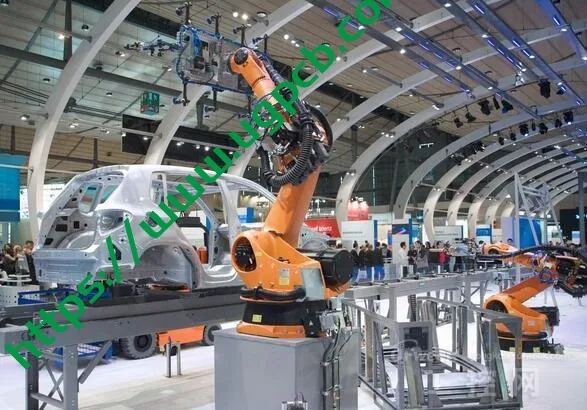 Intelligent Manufacturing (IM) is a human-machine integrated intelligent system composed of intelligent machines and human experts. It can perform intelligent activities such as analysis, reasoning, judgment, and expansion during the manufacturing process. Through cooperation between humans and intelligent machines, it expands, replaces, and partially extends part of human experts’ brainwork in the manufacturing process. It updates the concept of intelligent manufacturing, extending it to flexible, highly integrated, and intelligent manufacturing.
Intelligent Manufacturing (IM) is a human-machine integrated intelligent system composed of intelligent machines and human experts. It can perform intelligent activities such as analysis, reasoning, judgment, and expansion during the manufacturing process. Through cooperation between humans and intelligent machines, it expands, replaces, and partially extends part of human experts’ brainwork in the manufacturing process. It updates the concept of intelligent manufacturing, extending it to flexible, highly integrated, and intelligent manufacturing.
Undeniably, intelligentization is the direction of development of manufacturing automation. Artificial intelligence technology is widely applied in almost all links of manufacturing processes. Expert system technology can be used for engineering design, process design, production scheduling, fault diagnosis, ecc. Advanced computer intelligence methods such as neural networks, fuzzy control technology, ecc., can also be applied to product formulas, production scheduling, ecc., realizing intelligentization of manufacturing processes. Artificial intelligence technology is especially suitable for solving particularly complex and uncertain problems. But it is equally obvious that full intelligentization of the entire manufacturing process of enterprises is not entirely impossible, at least not in the near future. Even questions have been raised whether intelligent automation can be realized in the next century? Tuttavia, if intelligence is only implemented in a certain part of an enterprise without ensuring overall optimization then this kind of significance is limited.
Broadly speaking CIMS (Computer Integrated Manufacturing System), Agile Manufacturing, ecc. can all be considered examples of intelligent manufacturing examples. Gradually, through information integration, step-by-step intelligent design, intelligent management, and ultimately establishing an intelligent manufacturing system, increasing system-level optimization, gradually improving the intelligence level of the system, eventually establishing a smart manufacturing system might be a feasible path to achieving intelligent manufacturing.
From a broader perspective, generally speaking CIMS, agile manufacturing, ecc. can all be considered examples of intelligent manufacturing. Gradually through information integration, step-by-step intelligent design, intelligent management, and ultimately establishing an intelligent manufacturing system, increasing system-level optimization, gradually improving the intelligence level of thereby establishing a smart manufacturing system might be a feasible path to achieving intelligent manufacturing.
Whole subsystem
The basic component of the entire subsystem is the whole subsystem (Holon). Holon is borrowed from Greek. People use Holon to represent the smallest component in a system. The whole subsystem consists of many different types of Holons. The most fundamental characteristics of Holons are:
- Autonomy, where each unit can plan its own operational behavior, respond to emergencies (such as changes in manufacturing resources, changes in manufacturing task demands, ecc.), its behavior is controllable;
- Cooperation, where each entity can request other entons to perform operations for its own service requests;
- Intelligence, where each Holon has reasoning, judgment capabilities, which are also intrinsic to its autonomy and cooperation. These characteristics indicate that the whole subsystem has a similar concept to the agent.
The characteristics of the whole subsystem include:
- Self-organization capability, allowing rapid reliable construction of new markets and quickly changing manufacturing requirements;
- High adaptability, rapidly changing market demands and ever-changing manufacturing requirements;
- High flexibility, highly adaptable to rapidly changing market requirements and constantly changing manufacturing requirements;
- Bio-manalfacturing, green manufacturing, bio-manalfacturing models and other modes are also results of research results in the field of management science. They reflect the development of management science and are also results of automation technology and systems research. Looking ahead to the future, manufacturing automation will continue to move along historical tracks.
Automation control technology is one of the most important modern manufacturing technologies, mainly to solve the efficiency and consistency problems. Its development path is mostly based on the introduction of complete sets of equipment, followed by secondary digestion and absorption, and application and development. China’s industrial automation control technology, industria, and applications have made significant progress, with core technologies including basic automation, process automation, management automation, and integrated automation. The direction of industrial automation technology is towards intelligence, networking, integration, and modularization.
- Low-cost industrial control automation based on industrial PC will become the mainstream
It is well known that since the 1960s, Western countries have relied on technological progress (i.e. new equipment, new technology and computer applications) to transform traditional industries, leading to rapid industrial development. The biggest change in the world at the end of the 20th century was the formation of the global market. The global market has led to unprecedented fierce competition, prompting companies to speed up the time to market of new products (Time to MARKet), improve quality (Qualità), reduce costs (Costo) and improve the service system (Service), which is the T.Q.C.S. of the company. Although the computer integrated manufacturing system (CIMS) combines information integration and system integration to pursue a more perfect T.Q.C.S., it enables companies to “deliver the right information to the right people at the right time in the right way, so as to make the right product”. The right decision. ”, namely “Five Positives”. Tuttavia, this kind of automation requires a lot of capital investment. This is a high-investment, high-efficiency, high-risk development model that is difficult for most small and medium-sized enterprises to adopt. In China, small and medium-sized enterprises and quasi-large enterprises are still taking the low-cost path of industrial control automation.
Industrial control automation mainly includes three levels, from bottom to top, basic automation, process automation and management automation, among which the core is basic automation and process automation.
In traditional automation systems, the basic automation part is basically monopolized by PLC and DCS, and the process automation and management automation part is mainly composed of various imported process computers or minicomputers. The high prices of its hardware, system software and application software keep many merchants away.
Since the 1990s, due to the development of PC-based industrial computers (referred to as industrial PCs), PC-based automation systems consisting of industrial PCs, I/O devices, monitoring equipment, control networks, ecc. have been rapidly popularized and become an important way to achieve low-cost industrial automation.
Since PC-based controllers have been proven to be as reliable as PLCs and accepted by operators and maintenance personnel, one manufacturer after another has adopted PC-based control in at least part of their production. PC-based control systems are easy to install and use, and have advanced diagnostic functions, providing system integrators with more flexible options. In the long run, PC-based control systems have low maintenance costs. Since programmable logic controllers (PLCs) are most threatened by PC control, PLC suppliers are uneasy about the use of PCs. Infatti, they have also joined the “wave” of PC control.
Industrial PCs are developing extremely rapidly in China. From a global perspective, industrial computers mainly include IPC industrial computers and Compact PCI industrial computers and their variants, such as AT96 bus industrial computers. Since basic automation and process automation have high requirements for the operation stability, hot plugging and redundant configuration of industrial computers, existing industrial computers can no longer fully meet the requirements and will gradually withdraw from this field. Instead, they will be replaced by industrial computers based on CompactPCI, while industrial computers will occupy the management automation layer. In 2001, the state established a major industrial automation project of “industrialization of open control systems based on industrial control computers”. 50% of the domestic market and achieve industrialization.
A few years ago, when “soft PLC” appeared, the industry believed that industrial PCs would replace PLCs. Tuttavia, today’s industrial PCs have not replaced PLCs for two main reasons: one is the system integration reason; the other is the software operating system Windows NT. A successful PC-based control system must have two points: one is that all work must be done by software on one platform; the other is to provide customers with everything they need. It can be foreseen that the competition between industrial PCs and PLCs will focus mainly on high-end applications with complex data and high equipment integration. Industrial PCs cannot compete with low-cost micro PLCs, which are the fastest growing part of the PLC market. From the development trend, the future control system is likely to exist between industrial PCs and PLCs, and these signs of convergence have already appeared.
Like PLCs, the industrial PC market has remained stable in the past two years. Compared with PLCs, industrial PC software is cheaper.
- PLCs are developing towards miniaturization, networking, PCization, and openness
There are about 200 PLC manufacturers in the world, producing more than 300 prodotti. The domestic PLC market is still dominated by foreign products such as Siemens, Modicon, A-B, Omron, Mitsubishi, and GE. After years of development, there are about 30 PLC manufacturers in China, but they have not yet formed large-scale production capacity and brand-name products. It can be said that PLC has not yet formed manufacturing industrialization in China. In terms of PLC applications, China is very active and the application industry is also very extensive. Experts estimate that the sales volume of PLC in the domestic market in 2000 was 150,000 A 200,000 units (of which about 90% were imported), about 250 million to 3.5 billion yuan, and the annual growth rate was about 12%. It is expected that by 2005, the national demand for PLC will reach about 250,000 units, about 350 million to 4.5 billion yuan.
The PLC market also reflects the situation of the world’s manufacturing industry, which has declined sharply since 2000. Tuttavia, according to the forecast of Automation Research Corp, despite the global economic downturn, the PLC market will still recover. It is expected that the global PLC market will be US$7.6 billion in 2000, and will recover to US$7.6 billion by the end of 2005, and continue to grow slightly.
Miniaturization, networking, PCization and openness are the main directions for the future development of PLC. In the early days of PLC-based automation, PLCs were bulky and expensive. But in recent years, micro PLCs (less than 32 I/o) have appeared, and the price is only a few hundred euros. With the further improvement and development of soft PLC control configuration software, the market share of soft PLC configuration software and PC-based control will gradually increase.
Attualmente, one of the biggest development trends in the field of process control is the expansion of Ethernet technology, and PLC is no exception. Now more and more PLC suppliers are beginning to provide Ethernet interfaces. It is believed that PLC will continue to move towards open control systems, especially control systems based on industrial PCs.
- DCS system designed for integrated measurement, control and management
Distributed control system DCS (Distributed Control System) came out in 1975, and manufacturers are mainly concentrated in the United States, Giappone, Germany and other countries. Since the mid-to-late 1970s, my country first introduced foreign DCS from large-scale imported complete sets of equipment. The first batch of introduced projects included chemical fiber, ethylene, fertilizer, ecc. At that time, the DCS of major industries in my country (such as electricity, petrochemicals, building materials, metallurgy, ecc.) was basically imported. In the early 1980s, while introducing and digesting technologies, we started technical research on the development of domestic DCS.
The annual growth rate of China’s DCS market is about 20%, and the annual market size is about 3 billion (3.5 billion yuan). Since DCS has no alternative products in large-scale automatic control devices in the petrochemical industry in the past five years, its market growth rate will not decline. According to statistics, by 2005, my country’s petrochemical industry will need more than 1,000 sets of equipment controlled by DCS; the power system will install more than 10 million kilowatts of new generators, which will need DCS monitoring every year. Many companies have used DCS for nearly 15-20 years and need to be updated.
- Control system develops towards fieldbus (FCS)
Due to the development of 3C (computer, control, comunicazione) tecnologia, process control system will develop from DCS to FCS (fieldbus control system). FCS can completely distribute PID control to field devices (Field Device). FCS based on fieldbus is a new generation of fully distributed, fully digital, fully open and interoperable production process automation system. The structure brings revolutionary changes.
According to the definition of IEC61158, fieldbus is a digital, two-way transmission, multi-branch communication network between field devices installed in manufacturing or process areas and automatic control devices in the control room. Fieldbus enables measurement and control equipment to have digital computing and digital communication capabilities, improves the measurement, transmission and control accuracy of signals, and improves the functions and performance of systems and equipment. The SC65C/WG6 working group of IEC/TC65 began to work on introducing a single fieldbus standard worldwide in 1984. After 16 years of efforts, IEC61158-2 was launched in 1993, and the subsequent standard formulation fell into chaos. .
After the development of base-type pneumatic instrument control systems, electric unit combined analog instrument control systems, centralized digital control systems and distributed control systems (DCS), the development of computer control systems will move towards the development of fieldbus control systems (FCS). Although the fieldbus-based FCS has developed rapidly, there is still a lot of work to be done in the development of FCS, such as the unification of standards and the intelligence of instruments. Inoltre, the maintenance and transformation of traditional control systems also require DCS, so it will take a long process for FCS to completely replace traditional DCS, and DCS itself is also constantly developing and improving. It is certain that FCS will have strong vitality when combined with new technologies such as DCS, industrial Ethernet, and advanced control. Industrial Ethernet and fieldbus technology, as a flexible, convenient and reliable data transmission method, are increasingly used in the industrial field and will occupy a more important position in the control field.
- Instrumentation technology is developing towards digitalization, intelligence, networking and miniaturization
After 50 years of development, my country’s instrumentation industry has a solid foundation and has initially formed a relatively complete production, scientific research and marketing system, becoming the second largest instrumentation producer in Asia after Japan. As digital, intelligent, networked and miniaturized products gradually become the international mainstream, the gap will widen further. Most of my country’s high-end and large-scale instruments and equipment rely on imports. As far as mid-range products and many key components are concerned, foreign products account for more than 60% of the Chinese market, while domestic analytical instruments account for less than 2/1000 of the global market.
The main development trends of instrumentation technology in the future: Instrumentation will develop towards intelligence, thus producing intelligent instrumentation; PC-based measurement and control equipment and virtual instrument technology will develop rapidly; Instrumentation will be networked, thus producing network instruments and remote measurement and control systems.
A few suggestions: Develop products with independent intellectual property rights and master core technologies; Enhance the system integration capabilities of the instrumentation industry; Further expand the application areas of instruments.
- CNC technology develops towards intelligence, openness, networking and informatization
Since the Massachusetts Institute of Technology developed the first experimental CNC system in 1952, with the rapid development of computer technology, various open CNC systems of different levels have emerged and developed rapidly. In terms of structure, the CNC systems in the world today can be roughly divided into four types: 1. Traditional CNC system; 2. Open CNC system with “PC embedded in NC” struttura; 3. Open “NC embedded in PC” structure CNC system; 4. SOFT open CNC system.
The research and production of CNC systems in my country have made great progress through the introduction, digestion and absorption of industrialization during the “Seventh Five-Year Plan”, “Eighth Five-Year Plan” E “Ninth Five-Year Plan”. , production base, cultivated a group of CNC talents, initially formed its own CNC industry, and also promoted the development of electromechanical control and transmission control technology. Allo stesso tempo, after years of development, the economical CNC system with Chinese characteristics has greatly improved the performance and reliability of the product, and gradually gained recognition from users.
The overall development trend of foreign CNC system technology is: the new generation of CNC systems develops towards PC and open architecture; the drive device develops towards communication and digitization; and develops towards intelligence.
Entering the 21st century, human society will gradually enter the knowledge economy era, and knowledge will become the capital and driving force for the development of science and technology and production. The machine tool industry, as the equipment department for the development of mechanical manufacturing, the industry and even the entire national economy, is undoubtedly strategic and important, and will become more prominent.
Intelligence, openness, networking, and informatization have become the main trends in the development of future CNC systems and CNC machine tools: towards high speed, Alta efficienza, alta precisione, e alta affidabilità; towards modularization, intelligence, flexibility, networking, and integration; towards PCization and openness; With the emergence of a new generation of CNC processing technology and equipment, mechanical processing will develop towards virtual manufacturing; The combination of information technology (IT) and machine tools will develop advanced mechatronics machine tools; Nanotechnology will form a new development trend and have new breakthroughs; Energy-saving and environmentally friendly machine tools will accelerate development and occupy a broad market.
- Industrial control networks will develop in the direction of combining wired and wireless. Wireless LAN technology can easily connect network devices wirelessly, and people can access network resources anytime, anywhere and at will. It is an important direction for the development of modern data communication systems. Wireless LAN can provide Ethernet interconnection without using network cables. While promoting the development of network technology, WLAN is also changing people’s lifestyles. Wireless network communication protocols usually use IEEE802.3 point-to-point mode and 802.11 point-to-multipoint mode. Wireless LAN can be implemented on the basis of ordinary LAN through wireless hubs, wireless access points (APs), wireless bridges, wireless modems and wireless network cards, among which wireless network cards are the most commonly used. The future research direction of WLAN is mainly focused on security, mobile roaming, network management, and the relationship with other mobile communication systems such as 3G. In the field of industrial automation, there are thousands of sensors, detectors, computer, PLCs, card readers and other devices that need to be connected to each other to form a control network. Generalmente, the communication interface provided by these devices is RS-232 or RS-485. Wireless LAN equipment uses an isolated signal converter to convert the RS-232 serial port signal of industrial equipment into wireless LAN and Ethernet signals, which complies with the wireless LAN IEEE 802.11b and Ethernet IEEE 802.3 standard, and supports the standard TCP/IP network communication protocol, which effectively expands the network communication capabilities of industrial equipment.
The combination of computer network technology, wireless technology and intelligent sensor technology has produced a new concept of “networked intelligent sensors based on wireless technology”. This networked intelligent sensor based on wireless technology enables industrial site data to be directly transmitted, published and shared on the network through wireless links. Wireless LAN technology can provide high-bandwidth wireless data links and flexible network topology for communication between various intelligent field devices, mobile robots and various automation equipment in the factory environment, effectively making up for the shortcomings of wired networks in some special environments, further improving the communication performance of industrial control networks.
- Industrial control software develops towards advanced control
As an important part of industrial control software, the development of domestic human-machine interface configuration software has made great progress in recent years. The combination of software and hardware provides a relatively complete solution for the integration of measurement, control and management of enterprises. On this basis, industrial control software will develop from human-machine interface and basic strategy configuration to advanced control.
There is no strict and unified definition of advanced process control APC (Advanced Process Control). Generalmente, control algorithms based on mathematical models that must be implemented by computers are collectively referred to as advanced process control strategies. Such as: adaptive control; predictive control; robust control; intelligent control (expert system, fuzzy control, neural network), ecc.
Because advanced control and optimization software can create huge economic benefits, the value of these software has increased exponentially. Dozens of companies around the world have launched hundreds of advanced control and optimization software products, forming a powerful process industry application software industry worldwide. Perciò, it is of great significance to develop advanced control and optimization software with independent intellectual property rights in my country, break the monopoly of foreign products, and replace imports.
In futuro, industrial control software will continue to develop in the direction of standardization, networking, intelligence, and openness.
Industrial informatization refers to the realization of information collection, information transmission, information processing and comprehensive utilization of information on an integrated platform through information infrastructure in the process of industrial production, operation and management.
Vigorously developing industrial automation is an effective way and means to accelerate the transformation and upgrading of traditional industries, improve the comprehensive quality of enterprises, enhance the comprehensive national strength of the country, adjust the industrial structure, and rapidly revitalize large and medium-sized enterprises. For medium-sized enterprises, the state will continue to implement a series of industrial process automation high-tech industry industrialization projects, drive industrialization with informatization, promote the further development of industrial automation technology, strengthen technological innovation, realize industrialization, and deepen the solution – solve the outstanding problems facing the development of the national economy, further improve the overall quality and comprehensive national strength of the national economy, and achieve leapfrog development.
Provide industrial automation PCB proofing assembly, PCB proofing assembly, and printed circuit board assembly services. UGPCB is your one-stop PCB proofing assembly factory.
 LOGO UGPCB
LOGO UGPCB

